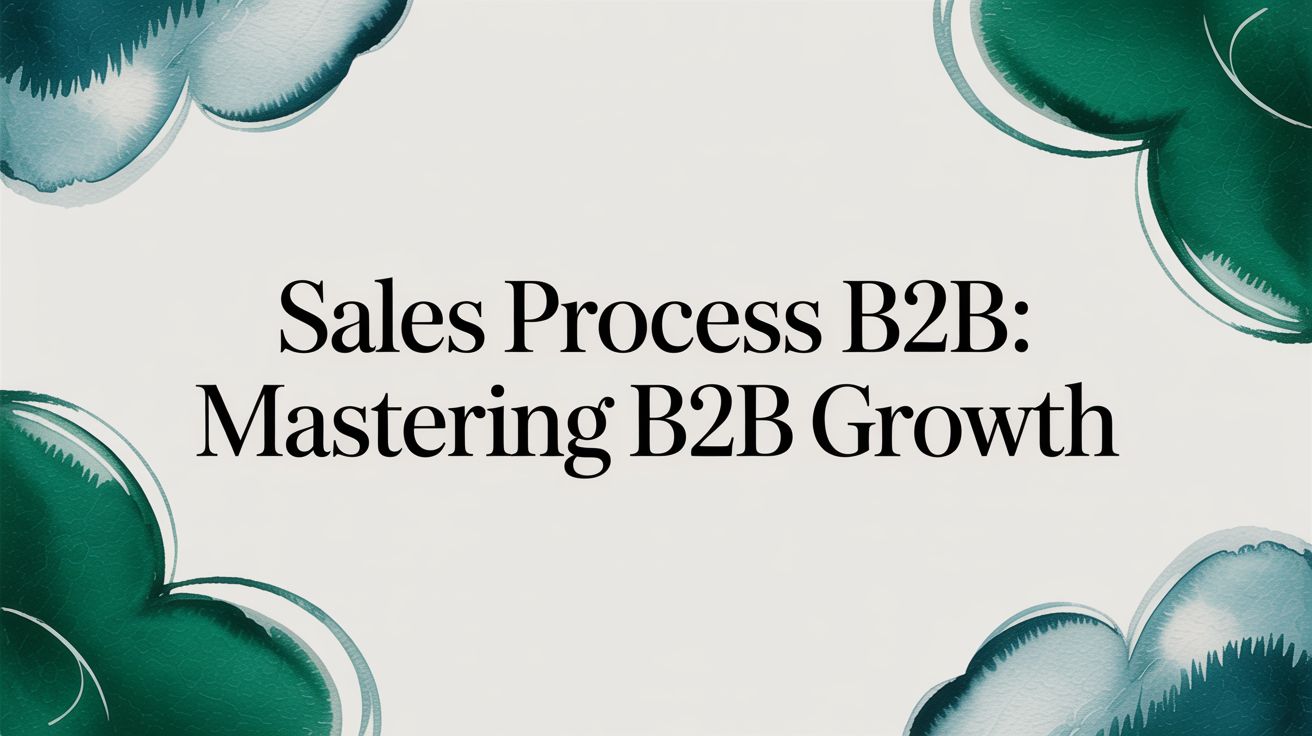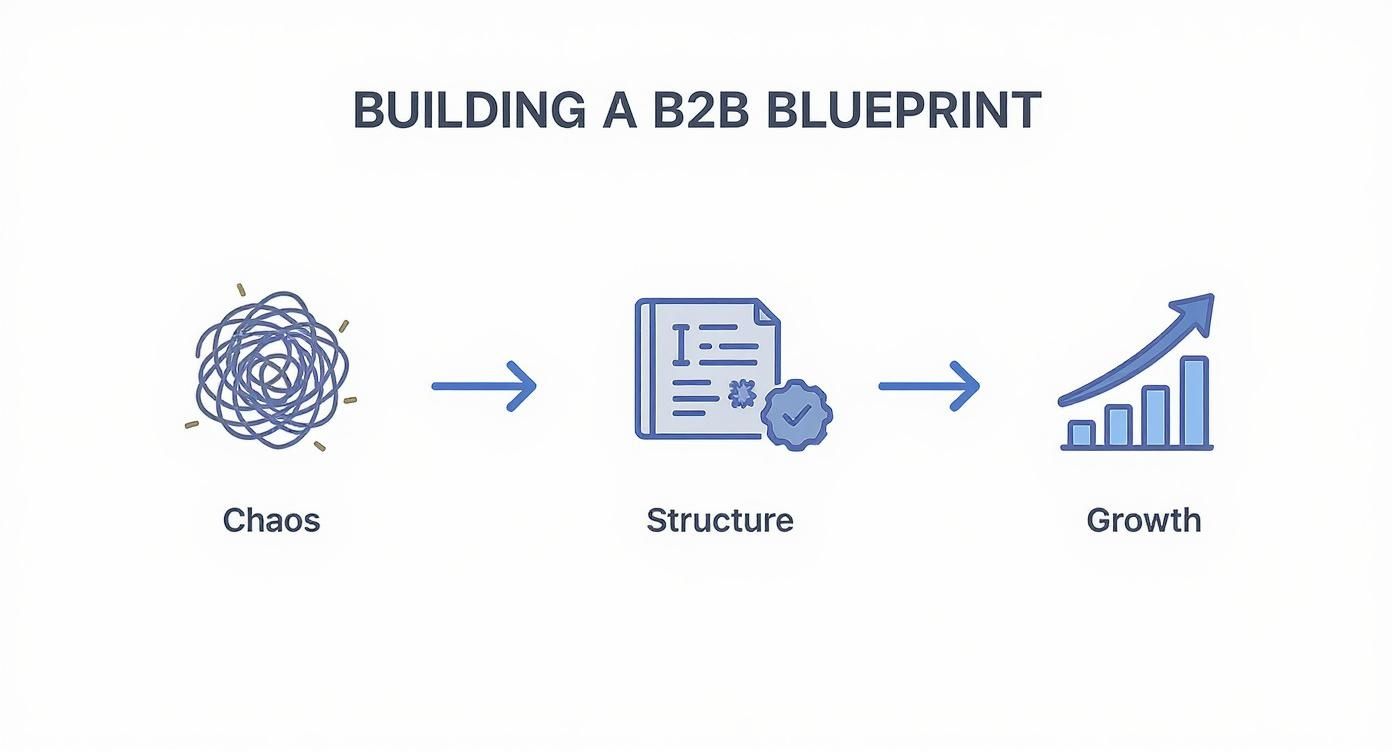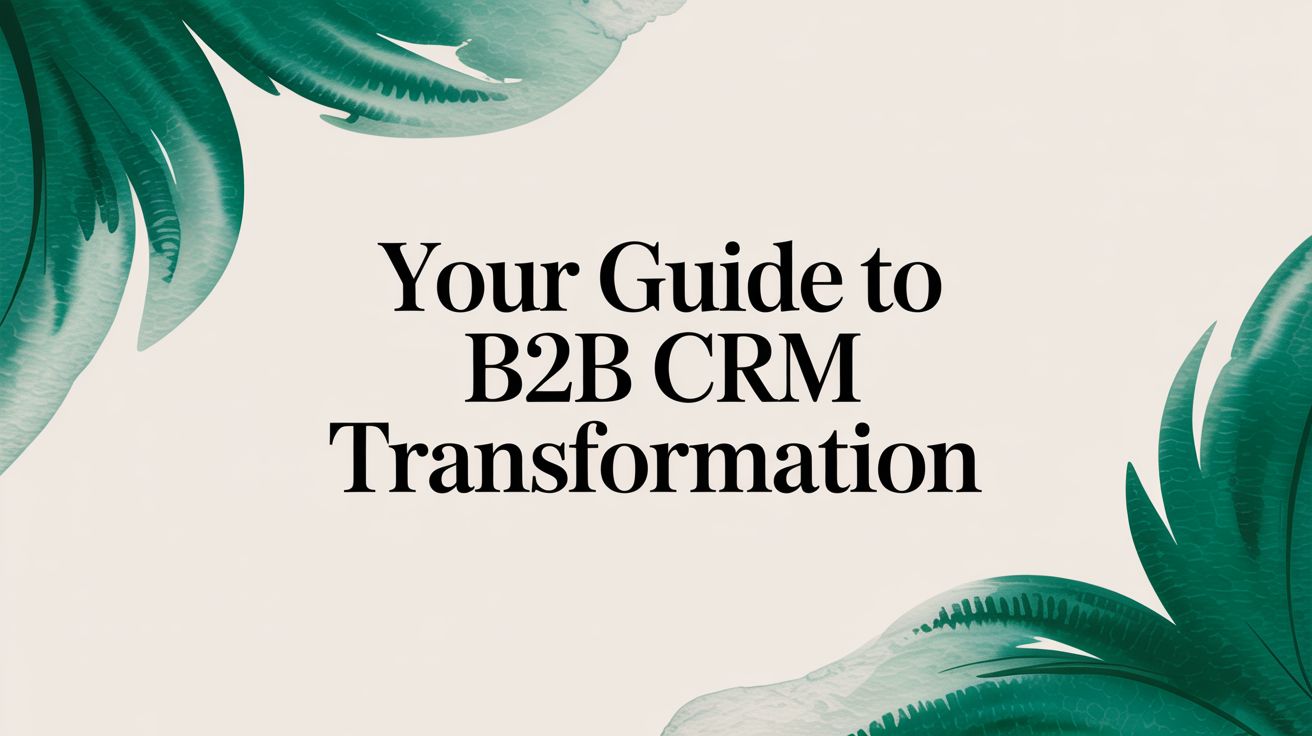sales process b2b: Mastering B2B Growth
October 27, 2025

Trying to scale a B2B sales team without a defined process is like trying to build a skyscraper without a blueprint. It’s chaotic, unpredictable, and almost guaranteed to come crashing down.
A structured sales process b2b is that blueprint. It turns sporadic wins and frantic activity into a repeatable, scalable framework for growth.
Forging a Path to Predictable Revenue
I once worked with a promising SaaS company that was stuck in a cycle of inconsistent results. Their sales team was full of sharp, talented people, but they all operated like independent artists instead of a coordinated crew. Each rep had their own methods for finding leads, running demos, and closing deals.
The result? Forecasts were a guessing game, and deals constantly slipped through the cracks for completely preventable reasons.
Everything changed when they finally committed to building a unified B2B sales process. By defining clear stages, qualification criteria, and handoffs, they completely transformed their sales operation. Within six months, they doubled their win rate—not by hiring more reps, but by giving their existing team a clear map to follow.
Their journey proves a powerful truth: A well-defined sales process isn't about restricting creativity. It's about creating a foundation upon which success can be consistently built.
This guide is designed to give you that same blueprint. We’re going to move beyond abstract theories and dive straight into an actionable playbook. You'll learn exactly how to:
- Define each stage of the sales cycle with precision.
- Implement best practices that drive momentum and build genuine trust.
- Establish clear alignment between your sales and marketing teams to ensure a seamless customer journey.
Let's get started building a system that turns random wins into a reliable engine for growth.
Navigating Each Stage of the B2B Sale
Think of a solid B2B sales process not as a rigid cage, but as a well-engineered bridge. It's the structure that safely guides your ideal customer from a place of mild curiosity all the way to a confident, signed deal. Each stage is a critical support pillar, and trying to skip one just weakens the entire structure. Real success comes from mastering each phase and perfecting the handoffs between them.
This journey starts long before you ever draft a proposal. It begins with identifying the right travelers for this bridge—the companies that stand to gain the most from what you offer. This is the crucial art and science of prospecting and qualifying.
This infographic shows the shift from chaotic sales efforts to the kind of structured, predictable growth a good process delivers.

What you're seeing is the essential move from disorganized activity to a clear blueprint for success. That structure is exactly what turns random sales motions into a reliable revenue engine.
Identifying the Right Opportunities
The first pillar of your process is Prospecting and Qualification. Think of this as the architectural survey before you start building your bridge; you have to find solid ground first.
Prospecting in B2B is the act of finding potential customers who match your ideal customer profile. Qualification, though, is where the real work happens. This is where you dig in to determine if they have a real, urgent problem you are uniquely equipped to solve. It’s less about pushing a product and more about diagnosing a genuine need.
When done right, qualification filters out the mismatches early on. This ensures your team invests its most valuable resource—time—on deals that actually have a legitimate chance of closing.
The real goal here is to get past surface-level interest. You need to uncover true buyer intent and separate the window shoppers from the serious buyers who actually have the authority and budget to pull the trigger.
Understanding the Core Challenge
Once you’ve qualified a lead, you move into Discovery and Needs Analysis. Now you’re digging the foundation for your bridge. Your goal is to shift from being a salesperson to becoming a trusted consultant.
This means asking sharp, open-ended questions that get beneath the surface. Instead of asking, "What are your goals?" try something like, "What are the consequences if you don't solve this problem in the next six months?" This kind of deeper questioning uncovers the true cost of doing nothing and the real, often emotional, drivers behind a potential purchase.
You can learn more about how this stage fits into the bigger picture by exploring the B2B sales funnel.
Presenting the Solution
Armed with a deep understanding of your client's pain points, you're ready for the Proposal and Presentation stage. At this point, you're building the main span of the bridge, connecting their specific problem directly to your solution.
A winning B2B proposal is never just a price list; it's a full-fledged business case. It should mirror the exact language, priorities, and pain points you uncovered during discovery. You need to frame your product not by its features, but by the outcomes it delivers. The proposal must clearly answer the "so what?" question for every single stakeholder involved, from the day-to-day user all the way to the CFO.
Securing the Partnership
The final stages are Negotiation and Closing. This is where you lay the last paving stones and finally open the bridge for traffic. This phase is a true test of the trust and rapport you’ve built throughout the entire process.
Successful negotiation in B2B is about collaborating to find a win-win scenario, not engaging in a battle of wills. It’s your chance to address final concerns, clarify terms, and reinforce the value you bring to the table. Closing the deal should feel like the natural, logical conclusion to a helpful, collaborative journey.
Keep in mind that as buying habits change, this stage is becoming more digital. By 2025, it's expected that more than half of large B2B purchases will happen through digital self-service channels, which shows a massive shift in buyer preferences. You can discover more Forrester predictions about the future of B2B sales to stay ahead of the curve.
Proven Tactics For Every Sales Stage
You know the stages of a B2B sales process—prospecting, qualification, discovery—but real wins come from nailing the details in each phase. Think of it as upgrading from a hand-drawn map to a GPS with live traffic updates. When you apply deliberate, battle-tested tactics at every turn, your funnel shifts from a hopeful pipeline into a predictable revenue engine.
Right now, that matters more than ever. The typical B2B buying journey drags on for 11 to 12 months, and global, multi-country deals can stretch to 16 months. Even worse, 86% of deals stall at the decision-making point. If you can’t keep the deal moving when it matters most, you’ll watch opportunities slip away. For the full deep-dive, check out B2B buyer journeys on SalesGlobe.com.
Prospecting Precision With Account-Based Strategies
Spraying generic emails at hundreds of names is like flicking pebbles at a battleship—sure, some might hit, but it won’t sink. Instead, top B2B performers zero in on a handful of high-value accounts that match their ideal customer profile to a tee.
• Identify 20–30 companies with the right size, budget, and pain points.
• Coordinate sales and marketing around those targets—one voice, one message.
• Research decision-makers’ priorities, recent business announcements, and org charts before you ever send the first email.
This consultative, account-by-account approach takes extra homework, but the return is huge. You’ll spend less time chasing unqualified leads and more time building conversations that lead straight to closed deals.
Mastering Qualification With Structured Frameworks
After that first touchpoint, qualification isn’t a rapid-fire interrogation. It’s a guided tour where you and your prospect explore whether there’s real alignment. Frameworks like MEDDICC serve as your map—use them flexibly rather than like a script.
- Metrics: “What improvements would you measure to say this project succeeded?”
- Economic Buyer: “Who signs off on the budget for this type of investment?”
- Identify Pain: “If we don’t solve this by next quarter, what impact will you feel?”
With those pillars in place, you capture the intelligence needed to build a rock-solid business case. When you’re ready to see how all these pieces fit into the big picture, head over to our full B2B sales process guide.
Turning Discovery Into A Strategic Consultation
Discovery calls aren’t about reciting features—they’re about uncovering problems your prospect didn’t even realize they had. Swap “Do you need X feature?” for “What’s the biggest roadblock keeping your team from hitting its goals?” Suddenly, you’re not a salesperson; you’re a trusted advisor.
A great discovery call feels like a free consulting session, where your questions spark insights for the prospect.
Below is an example of what a CRM pipeline view might look like, visualizing how opportunities move through these defined stages.

This visual snapshot helps you spot red flags early, measure deal health, and forecast revenue with confidence.
B2B Sales Stage Playbook
Below is a quick playbook that lays out each stage, the must-do actions, proven best practices, and the most common pitfalls to watch for.
Use this playbook as a quick reference to keep each stage on track.
By weaving these tactics into your daily routine, you turn every sales stage into an opportunity to build credibility, demonstrate value, and guide prospects confidently toward signing on the dotted line.
Measuring What Truly Matters in B2B Sales
You can't improve what you don't measure. We’ve all heard it. But in the tangled world of a B2B sales process, tracking the wrong things—like call volume or emails sent—creates a false sense of security while revenue stalls. Busy doesn't equal productive.
True progress comes from laser-focusing on the metrics that directly reveal the health and efficiency of your sales engine. These aren't just numbers on a spreadsheet; they're diagnostic tools. They tell you exactly where your process is strong and, more importantly, where it's breaking down and leaking cash.
Key Metrics for a Healthy B2B Sales Process
While every B2B business has its quirks, a few core KPIs offer a powerful, honest snapshot of your sales performance. These metrics go way beyond simple activity tracking to measure the actual effectiveness of your efforts, from the first touch to the final close.
Lead-to-Opportunity Conversion Rate: This is the percentage of qualified leads that turn into active sales opportunities. A low rate here is a massive red flag. It often points to a serious disconnect between what marketing calls a "lead" and what your sales team actually considers qualified.
Customer Acquisition Cost (CAC): Simply put, this is the total sales and marketing cost to win a single new customer. Keeping a close eye on your CAC ensures your growth is profitable, not just expensive. Get a detailed breakdown of how to calculate customer acquisition cost to get a real handle on this number.
Average Deal Size: Tracking this shows you which market segments or product offerings are driving the most value. A steadily increasing average deal size is a fantastic indicator of a healthy, maturing sales motion. It means you're getting better at selling value.
The Power of Sales Velocity
One of the most powerful, yet criminally overlooked, metrics is sales velocity. Think of it as the speedometer for your revenue engine. It measures how quickly deals are moving through your pipeline and turning into actual cash in the bank.
Sales velocity isn't about closing more deals; it's about closing the right deals faster. It combines the number of opportunities, average deal size, and win rate, divided by the length of your sales cycle.
A services firm I know increased their revenue by 25% in a single year without adding a single new salesperson. They didn't even increase their total number of closed deals. What did they do? They became obsessed with shortening their sales cycle.
They pinpointed massive bottlenecks in their proposal and negotiation stages and relentlessly worked to remove them. Their sales velocity soared, and their revenue followed suit. This proves that small, targeted improvements in efficiency can have an absolutely massive financial impact.
Building a Dashboard That Drives Action
Look, the goal of tracking these metrics isn't just to report on what happened last quarter. It's about guiding what you do next. A well-designed performance dashboard should give you an at-a-glance view of your sales engine's health.
It needs to immediately answer your most critical questions:
- Are we generating enough high-quality opportunities?
- How quickly are those opportunities actually moving toward a close?
- Is our cost to acquire customers sustainable, or are we just buying revenue?
By focusing on these core performance indicators, you can finally move beyond guesswork. You'll be equipped to provide meaningful coaching to your team, make data-backed strategic decisions, and build a truly predictable revenue machine.
Winning Over the Modern B2B Buyer

Let's be blunt: the old playbook for the B2B sales process is broken. Gone are the days when a buyer waited patiently for your call to learn about a solution. Today's B2B buyer shows up to that first conversation already an expert in your space. They’re more informed, more skeptical, and frankly, more in control than ever before.
Imagine an operations director we'll call Alex. She’s been tasked with finding a new project management platform. Long before your sales team even knows her company exists, Alex has devoured a dozen G2 reviews, watched on-demand demos from three of your competitors, and crunched a preliminary ROI based on everyone's public pricing pages.
By the time she finally fills out your "Contact Us" form, she’s not looking for a sales pitch. She's looking for a final validation on a decision she's already 90% of the way to making. Alex's journey isn't the exception anymore; it's the rule. This shift requires a fundamental rethinking of how we sell. Guarding information and pushing for a demo is a relic of the past. To win now, you have to build trust and deliver value long before you ever speak to them.
Adapting to the Self-Sufficient Buyer
Today's B2B buyer is on a self-service mission. They want autonomy. They want to do their own homework on their own timeline, without a salesperson breathing down their neck. Forcing a sales call too early feels less like helping and more like ambushing.
The data backs this up in a big way. Research shows that nearly 70% of a B2B buyer’s journey is over before they ever speak to a sales rep. What's more, a staggering 75% of buyers actually prefer a rep-free experience altogether. You can dig into more of these trends on Spotio's sales statistics roundup. They lean on digital content, peer reviews, and product-led tools to make their choice.
This means your sales process can't start with a discovery call. It has to start with a powerful, digital-first presence that empowers buyers instead of gatekeeping information.
Building Credibility Before the Conversation
To thrive in this new world, your team’s mindset needs to shift from selling to enabling. The goal is to become the most helpful, transparent, and trusted resource in your industry. That’s how you earn a seat at the table when the buyer is finally ready to talk.
This requires a few key changes in your approach:
- Provide Self-Service Tools: Stop hiding your value. Offer interactive demos, ROI calculators, and crystal-clear pricing pages that let prospects explore your solution's impact on their own terms.
- Create High-Value Content: Go beyond surface-level blog posts. Develop in-depth guides, data-rich case studies, and practical webinars that solve your buyer's real-world problems and strategic challenges.
- Embrace Radical Transparency: Be honest and upfront about what your product does well and where its limits are. This kind of authenticity builds the deep trust that actually closes deals.
The best modern sales teams don't just sell products; they facilitate decisions. They understand their job is to guide an already-informed buyer to the best possible conclusion for their business—even if that conclusion isn't a sale today.
Mastering this starts with an almost obsessive understanding of who your buyer truly is. Building detailed buyer personas is no longer a fluffy marketing exercise; it's the bedrock of a successful sales strategy. A great starting point is learning how to start using buyer personas to accelerate your B2B marketing and sales and aligning your entire process around their actual journey.
When you meet the modern buyer where they are—online, self-educating, and in full control—you transform your sales process from a confrontational pitch into a welcome consultation. And that’s how you win their trust, their respect, and ultimately, their business.
Actionable Steps to Refine Your Sales Process
Inspiration is great, but execution is what gets results. We've covered the principles for building a stronger B2B sales process, but turning those ideas into reality takes a concrete plan. This is your roadmap—a clear, five-point action plan you can start on today.
Think of your sales process less like a document locked away on a shared drive and more like a living system. It has to evolve with your market, your buyers, and your team. The goal isn't a one-time setup; it's continuous refinement.
Your 90-Day Implementation Plan
Trying to overhaul everything at once is a recipe for disaster. It's overwhelming and you'll struggle to see what's actually working. Instead, focus on piloting a few targeted improvements over the next 90 days. This approach lets you measure the real-world impact, gather feedback from the team, and build momentum for bigger changes down the line.
Here’s your immediate action plan:
Audit Your Current Process: Get brutally honest about where things are breaking down. Where do deals stall most often? Interview your sales reps and dig into your CRM data to find the biggest bottlenecks. Is it the lead qualification stage? The proposal? Maybe it's negotiation. Pinpointing the problem is the first step toward fixing it.
Define Clear Stage Criteria: Eliminate the guesswork. For every single stage in your pipeline, write down the exact, non-negotiable criteria a deal must meet to move forward. This simple step ensures everyone on the team is working from the same playbook and speaking the same language.
Select Your Core KPIs: Don't drown in data. Choose just three to four key metrics to track obsessively. Good starting points are sales velocity, lead-to-opportunity conversion rate, and average deal size. Focus on the numbers that give you a true signal of health, not just noise.
A great sales process is never truly "finished." It's a system you constantly test, measure, and improve. Think of it as tuning a high-performance engine—small, consistent adjustments are what unlock maximum power and efficiency over time.
Align Sales and Marketing: This is non-negotiable. Schedule a joint meeting to walk through your newly defined stage criteria and KPIs. You need both teams to agree on exactly what a qualified lead looks like and how the handoff will work. When these two teams are in sync, the entire engine runs smoother.
Empower Your Team: Give your people the tools they need to win. Based on your audit, identify one or two things that will directly solve a bottleneck. It could be a better feature in your CRM, a polished proposal template, or a set of materials outlining your market position. Give your team the resources they need to execute flawlessly.
- Building standardized proposal templates. This stops your team from reinventing the wheel for every single deal.
- Getting ahead of common objections. Bring them up yourself during discovery so they don't pop up as surprises at the finish line.
- Empowering your champion. Give them self-serve tools like ROI calculators so they can build the internal business case without having to wait on you for every little thing.
By taking these tangible steps, you'll start turning abstract ideas into real-world improvements, building a sales engine that’s not just effective but truly built to last.
Frequently Asked Questions
Even the best-laid sales processes run into real-world challenges. Let's tackle some of the most common questions that pop up when you start putting these ideas into practice.
How Can We Shorten Our Long B2B Sales Cycle?
A long sales cycle is almost always a sign of friction. Deals don't just drag on for no reason—they get stuck. The fastest way to speed things up is to figure out where those bottlenecks are and smooth them out.
Start by mapping your current process from first touch to signed contract. Where do deals consistently slow down or go dark? Often, the biggest delays pile up around the proposal and negotiation stages.
You can inject some serious speed into this final stretch by:
How Do We Align Our Sales and Marketing Teams?
This is the classic B2B problem, and it's responsible for more missed targets than almost anything else. Real alignment doesn't come from team-building exercises; it comes from having a shared definition of what a good lead actually is.
Both teams need to agree on a single, unified definition of a "sales-qualified lead" (SQL).
Think of this definition as a service-level agreement (SLA) between the two departments. Marketing promises to deliver leads that meet these exact criteria, and in return, Sales promises to follow up diligently on every single one of them. No more finger-pointing.
Get both teams in a room and hash out the criteria together. Once you've got it locked in, build those rules directly into your CRM and review your performance against them every single week. This creates a feedback loop built on data, not drama.
Can a Small Business Implement a Formal Sales Process?
Not only can you, but you absolutely should. When every single lead and every hour counts, a structured process is what keeps you from wasting precious resources.
You don't need a six-figure software budget to get started. A simple spreadsheet or a basic, low-cost CRM is more than enough.
The magic isn't in the tool; it's in the discipline. Define the handful of stages that matter for your business and establish clear rules for what it takes to move a deal from one to the next. Start by just mapping out what you're already doing—even if it feels informal—and pick one or two spots to improve. Consistency is always more important than complexity.
Ready to build a sales process that drives predictable growth? Big Moves Marketing specializes in creating the positioning, sales tools, and launch strategies that help B2B SaaS and AI startups win deals and scale effectively. Learn how we can help you at https://www.bigmoves.marketing.
%20-%20Alternate.svg)

%20-%20white.svg)